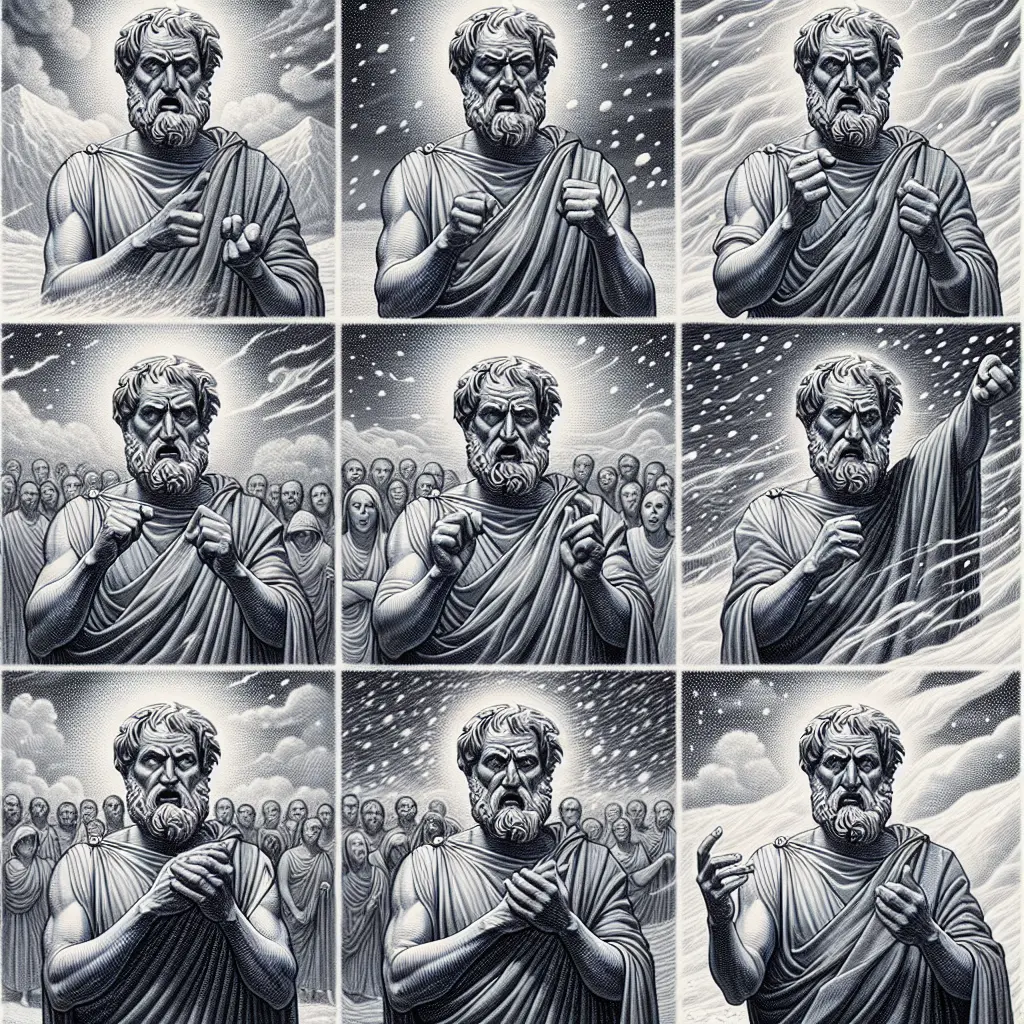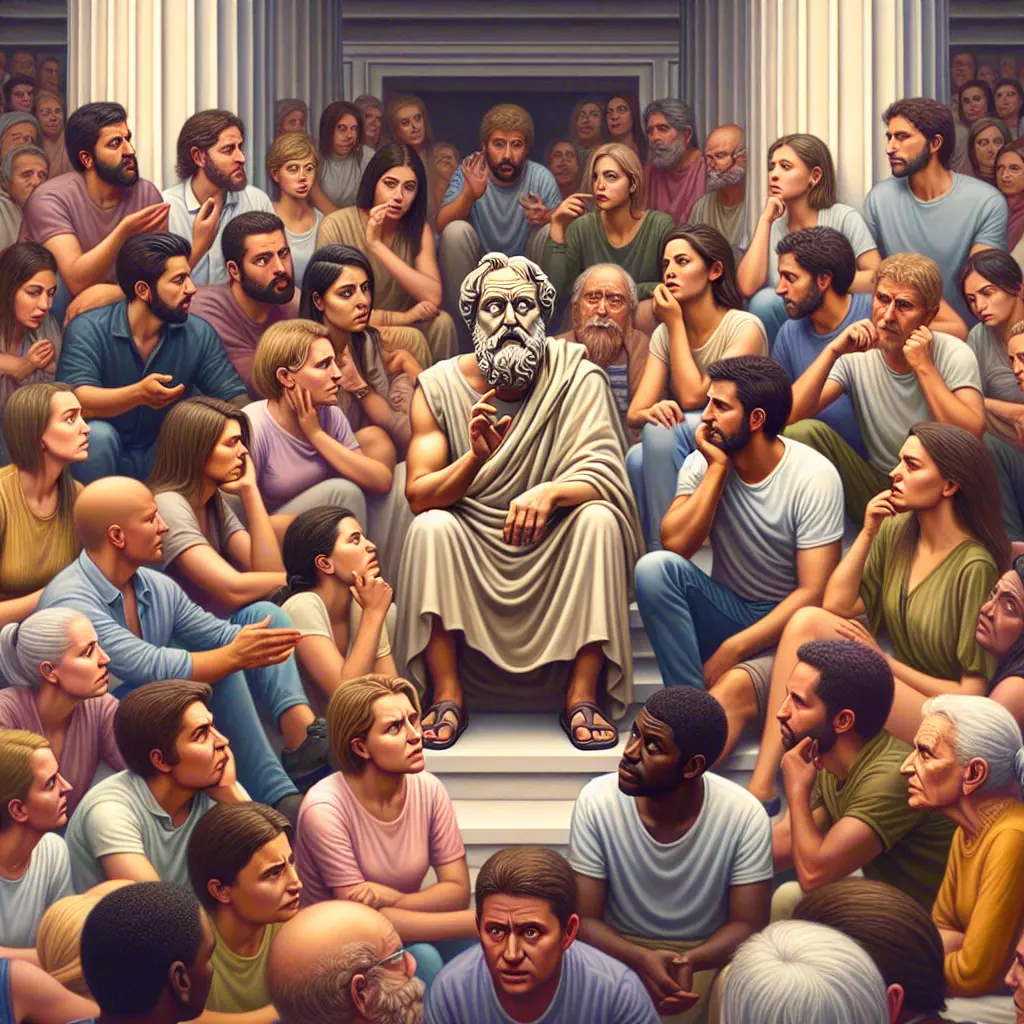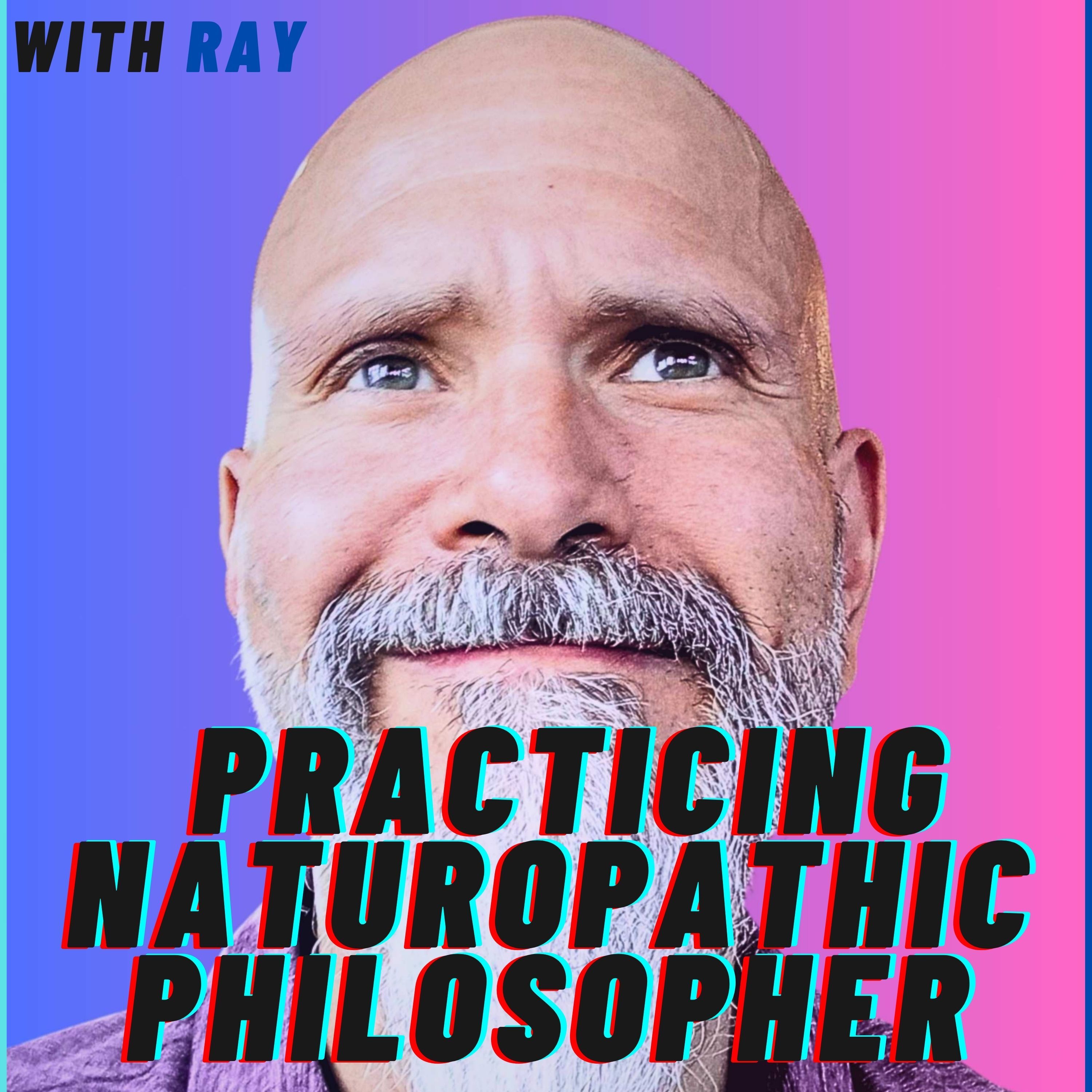Decoding Discursiveness: Why Focused Reading Matters According to Seneca
Decoding discursiveness: why focused reading matters according to Seneca.
Seneca's letter 'On the Discursiveness in Reading' offers profound insights into the uniqueness of the human mind's tendency to wander and the importance of cultivating where you are with divine focus. In a world teeming with distractions, his words resonate more powerfully than ever in our current time. This blog post delves into the core concept of 'discursiveness,' as Seneca wisely defines it, and explores how his wisdom on focused reading can be applied to your modern, distraction-filled lives. We will examine the challenges, provide practical strategies, and connect Seneca's principles to your holistic well-being. This exploration provides additional context for Episode 5: Letter 2: On Seneca: On Discursiveness of Reading📚📕📘 on Practicing Naturopathic Philosophers Podcast, where we discuss these ideas in greater depth. I chose this image as we observe, contemplate while weathering our storms and then choosing a decision. Our minds will temper through our tempests(storms) as we get good at making quick decisions that serve us. Look upon this image and think of all the storms you have weathered in this life while working to make good decisions during these seasons of our life. I bet you can see yourself in each of these images.
A triptych of a stoic, bearded man with a stern expression, dressed in a classical Greek toga. He is depicted in various poses of impassioned oration, with his arms gesturing expressively. The background varies across the panels: one shows a dramatic, cloudy sky with mountainous silhouettes; another features a crowd of onlookers with downcast or attentive faces; and a third depicts a snowy, ethereal landscape with falling flakes. The overall style is reminiscent of a woodcut or linocut, with strong contrasts between light and shadow, and a monochromatic palette of blues, grays, and whites. The lighting is dramatic and chiaroscuro, emphasizing the man's powerful presence and the intensity of his message. The perspective is generally at chest level, focusing on the orator's face and upper body
Introduction: Why Seneca's Wisdom on Reading Matters Today
In an era defined by information overload and relentless digital stimulation, the ability to concentrate has become a precious commodity. We are constantly bombarded with notifications, updates, and an endless stream of content vying for our attention. Don't let this steal who you are. It’s easy to feel scattered, overwhelmed, and unable to truly absorb the information we consume. Seneca, the Roman Stoic philosopher, recognized this struggle centuries ago. His letter 'On Discursiveness in Reading,' addressed to Lucilius, offers a timeless solution to the problem of scattered, unfocused reading – a problem that has only intensified in our modern age. I personally read books so I can focus on the information. Seneca's insights into disciplined thinking and the value of understanding oneself are relevant and vital for anyone seeking a more mindful, productive, and fulfilling life.
What is Discursiveness? Decoding the Lock of Seneca's Key Concepts
The term "discursiveness" refers to a wandering, rambling, or unfocused approach to reading and thinking. It describes a state of mental restlessness where the mind jumps from one subject to another without truly engaging with any of them. Seneca observed that many people flit from book to book, author to author, never allowing themselves to delve deeply into any particular subject's material to get a grasp. This superficial engagement, he argued, prevents true understanding and hinders personal growth. In essence, discursiveness is the antithesis of focused, intentional learning. It is a habit that cultivates mental fragmentation, preventing us from forming coherent thoughts and developing a comprehensive understanding of the world around us. PAUSE-- reflect on this for a moment to see where you have gone astray.
Seneca's Letter💌 : A Summary and Exploration
Seneca's letter to Lucilius provides a compelling argument against discursiveness. He encourages Lucilius (and, by extension, us) to choose a few select authors and to immerse himself in their works. He argues that consuming a wide variety of sources superficially is like eating a smorgasbord of dishes without truly savoring any of them. True knowledge, he contends, comes from repeated exposure to the same material, allowing the mind to fully soak it in, absorb and integrate to assimilate the information. Seneca emphasizes the importance of mastering a few fundamental principles rather than accumulating a vast collection of disconnected facts. He also suggests that we should not simply read for the sake of reading, but to internalize the lessons and apply them to our lives. (Re-read that...)This active engagement with the text is crucial for transforming knowledge into wisdom. The image below shows an image of one man reading while the other man is reading and applying his wisdom in the battlefield of life or the arena. How many books have you written and not applied? Knowing and doing are two different things.
A diptych composition. On the left, a medieval knight in full, ornate silver armor stands triumphantly on a blood-soaked battlefield, one foot resting on a fallen soldier. The knight holds an open book in his gauntleted left hand, gazing outwards as if towards victory. A sword is plunged into the ground beside him. In the background, a vast army marches under a dramatic, cloudy sky. The scene is rendered with realistic detail, emphasizing the metallic sheen of the armor and the gritty texture of the battlefield, with a warm, golden light suggesting late afternoon.On the right, a scholar in a dark suit and a red apron stands in a grand, wood-paneled library, reaching for a book on a towering bookshelf filled with leather-bound volumes. He wears glasses and is engrossed in reading an open book. The lighting is soft and warm, emanating from an unseen source, casting gentle shadows and highlighting the rich textures of the wood and books. The mood is serene and intellectual, a stark contrast to the battlefield. The overall style is realistic with a touch of dramatic flair in the lighting and composition. Who would you rather be?
The Pitfalls of Modern Distractions: Parallels to Seneca's Concerns
Seneca's concerns about discursiveness are strikingly relevant in our modern world. Can you see it? The constant stream of notifications, social media updates, and clickbait articles creates a perfect environment for scattered thinking. We are constantly bombarded with information, making it difficult to focus on any one thing for an extended period. This digital overload can lead to a sense of mental fatigue, anxiety, and an inability to concentrate. Just as Seneca warned against flitting from book to book, we must be wary of jumping from one website to another, one social media platform to another, without truly engaging with the content. This is advice for me as well as I have like 36 windows open that I do go back and re-use. On Sunday I go and close windows that I no longer are using. The key is to cultivate a mindful approaches to technology, consciously limiting distractions and creating space for focused attention.
Laser Focus and Consistency: Applying Seneca's Principles to Daily Life
Seneca's advice on focused reading can be extended to other areas of our lives. Just as he advocated for immersing ourselves in the works of a few select authors, we can benefit from focusing our attention on a few key goals and pursuing them consistently. This means identifying our priorities, setting clear intentions, and dedicating our time and energy to the activities that truly matter. It also means learning to say no to distractions and commitments that do not align with our goals. By cultivating focus and consistency, we can achieve greater clarity, productivity, and a sense of purpose in our lives. This principle ties directly into the advice that Ray shares on Practicing Naturopathic Philosophers Podcast where he emphasizes the importance of disciplined, focused thinking, and the value of understanding oneself. Listen in for a deeper comprehension of these valuable life lessons. To me this image is about overthinking and not acting. We are all sitting around thinking and we think ourselves into NO ACTION. Do you relate to this?
A highly detailed, realistic depiction of Socrates, with a flowing white beard and hair, clad in a simple, draped toga, seated centrally on white marble steps. He is gesturing with his right hand, engaged in discourse with a diverse crowd of men and women of various ages and ethnicities surrounding him. The crowd is seated on the steps and the ground, their faces turned towards Socrates with expressions of rapt attention, contemplation, and curiosity. The setting appears to be an ancient Greek amphitheater or courtyard, with large classical columns visible in the background. The lighting is soft and natural, casting a gentle glow on the scene and highlighting the textures of the fabric and skin. The overall mood is one of intellectual engagement and profound discussion. The perspective is slightly from below, emphasizing Socrates' position as the central figure and intellectual leader. The color palette is dominated by earthy tones, whites, and muted blues and greens, creating a timeless and classical atmosphere. The style is reminiscent of Renaissance or Neoclassical painting.
Beyond Reading📖📕📘 : The Importance of Holistic Well-being (Food, Health, and Lifestyle Alignment)
Seneca's philosophy extends beyond the intellectual pursuits to encompass the importance of holistic well-being. He believed that a healthy mind resides in a physically healthy body, and that our physical and mental states are interconnected with each other. Therefore, he emphasized the importance of proper nutrition, regular exercise, and an aligned lifestyle. Consuming wholesome, natural foods provides you the energy and nutrients our brains need to function optimally. Regular exercise improves circulation, reduces stress, and enhances cognitive function. And cultivating these daily healthy habits, such as getting enough sleep(or as much as you can get), managing stress, and investing time with nature, can all contribute to a more focused and productive mind. In short, taking care of your physical well-being is essential for cultivating mental clarity and laser-like focus on what is really important to you.
Choosing (Quality) Over Quantity: A Stoic Approach to Consumption
The Stoic philosophy emphasizes the importance of virtue, reason, and living in accordance with nature. This includes making conscious choices about what we consume daily, whether it's food, information, or material possessions. Seneca encourages us to prioritize quality over quantity, choosing experiences and relationships with people that enrich our lives rather than accumulating things that provide only fleeting pleasure. This principle applies to our consumption of information as well. Are we consuming it or is it consuming us? Rather than trying to consume everything, we must focus on acquiring knowledge that is truly valuable and relevant to our vision of our one great life. By adopting a Stoic approach to consumption, we can cultivate a more mindful, intentional, and fulfilling life by taking action on what we want to do.
The Value of 'Standard Authors': Why Focused Reading Cultivates Wisdom
Seneca's emphasis on reading "standard authors" is not about blindly following tradition, but about engaging with works that have stood "the test of time." These classic texts offer profound insights to our challenges into the human condition, exploring universal themes and timeless truths that we can put into practice. By immersing ourselves in these works, we can develop a deeper understanding of ourselves, the world around us, and the challenges and opportunities we can leverage for ourselves. Reading standard authors is not just about acquiring current knowledge; it's about cultivating applied wisdom, developing critical thinking skills, emotional regulation and expanding our perspectives with our creative edge. These classic works are foundational to understanding the ideas that built society around us, and helps us become a better global citizen. This image below to me is about sharing our growth with others.
A surreal, illustrative collage depicting the progression of human connection and life stages. The composition is divided into four quadrants, subtly blended.
Consistency Over Intensity: A Stoic Approach to Training
Seneca's philosophy also emphasizes the importance of consistency over intensity in our pursuits. Whether it's reading, exercising, or pursuing a particular skill, consistent with our effort over time becomes more effective than sporadic bursts of intense activity. This is because consistency allows us to build momentum, develop habits, and gradually improve our abilities. It also prevents burnout and fosters a sense of sustainable progress. Also, as a practicing naturopathic philosopher I do believe when you have been consistent long enough that it's time to up your intensity (at the same time) so you can level up.
Just as Seneca advocated for consistently engaging with the works of select authors, we should strive to cultivate a consistent approach to our goals, making steady progress each day rather than trying to achieve everything at once. Also, being intense with our learning of the subject matter so we can apply this wisdom ASAP>
Courage and Self-Improvement: Embracing the Challenges of Growth
Self-improvement is not always easy. It requires the courage of fear to confront our weaknesses, to challenge our assumptions, and to step outside of our comfort zones. I believe "Pressure is a Privilege." Think on this... It helps us become our best versions or our worst, so we can learn from the mis-takes and then do them over getting better in the process. Seneca recognized that personal growth often involves facing difficult to hard challenges, overcoming obstacles, and enduring setbacks as setups. However, he believed that these challenges are essential for developing resilience, character, and wisdom in ourselves by seeking this divine wisdom of change. By embracing the challenges of growth, we can become stronger, more capable, and more fulfilled individuals. The journey of self-improvement is a lifelong process, and it is one that is ultimately worth pursuing ourselves so we can build confidence that brings out intense trust in ourselves.
Wealth, Contentment, and the Pursuit of a Meaningful Life
Seneca's philosophy challenges our conventional notions of wealth and success. He argued that true wealth is not measured by material possessions, but by inner contentment, peace of mind, and the ability to live in accordance with virtue. He believed that the pursuit of material wealth often leads to anxiety, dissatisfaction, and a constant craving for more. Instead, he encouraged us to focus on cultivating inner virtues, such as wisdom, courage, justice, and self-control. By living a virtuous life, we can find true contentment, regardless of our external circumstances. This also requires that we have a goal that is bigger than ourselves that we can contribute to. By contributing to something bigger than ourselves, we develop a sense of meaning and purpose, and create the conditions for a flourishing life. Look at this image as both the lightness and darkness that's in your life. You learn and cannot enjoy one without the other. If you didn't have rain how could you not enjoy the sun.
A dramatic, abstract composition featuring a vertical split down the center, dividing the scene into two distinct halves. The left side is bathed in intense, radiating beams of vibrant orange and yellow light, emanating from a bright source at the top and fanning out downwards. This warm light casts strong, dramatic shadows across a textured, dark surface. The right side of the composition is illuminated by cool, sharp beams of electric blue and white light, also originating from the top and spreading downwards. These cooler tones create a contrasting effect, casting sharp, elongated shadows that stretch across the same dark, textured surface. The overall impression is one of powerful contrasting energies, with the light sources creating a striking visual dichotomy. The perspective is a low-angle, slightly downward view, emphasizing the dramatic spread of light and shadow. The mood is intense, dynamic, and somewhat ethereal.
Building a Better Version of You: Practical Steps🪜 Inspired by Seneca
Inspired by Seneca's wisdom, here are some practical steps you can take right now to cultivate a more focused, intentional, and fulfilling you:
- Limit Distractions: Consciously reduce your exposure to digital distractions, such as social media and notifications. Building a good life will take everything you have. Remember these devices are used to control you, not the other way around..
- Focus on One Thing at a Time: Practice single-tasking rather than multi-tasking, giving your full attention to the task at hand. They call this "mono-tasking." You will have to do multiple things during your "One Thing." Do each one well until completion.
- Choose Quality Over Quantity: Select a few key authors, resources, or goals and focus your energy on mastering them. I'll choose a few authors and read the book, then read it again to take notes, and apply those actions asap.
- Cultivate Consistency: Develop a consistent routine for reading, exercise, and other important activities. Plan them daily and place them in your phone or on a written calendar so you Get Stuff Done!
- Practice Mindfulness: Invest attention in the present moment without judgment, cultivating awareness of your thoughts and feelings. Also, powerful men and woman learn to channel, "Calm-Confidence," so they can make great decisions.
- Prioritize Holistic Well-being: Take care of your physical health through proper nutrition, exercise, hydration, who you surround yourself with and rest when it's time to rest (not before or after).
- Embrace Challenges as Changes: View setbacks as opportunities to leverage your growth and learning.
- Seek Contentment: Focus on cultivating inner virtues rather than pursuing external rewards.
- Reflect on Your Values: Identify your core values and align your actions with them. Know "Who You Are?" and "What You Stand For?" You will go to the grave with these beliefs as they create who you will become.
- Contribute to Something Bigger Than Yourself: Helping others in need provides a sense of purpose and fulfillment to you.
Final Blinking Thoughts: Cultivating an Intentional Life is about Being Mindfully Aware...
Seneca's driven insights into discursiveness (all over the place) and then focused reading offer a timeless guide to cultivating a more mindful, intentional, and fulfilling life. By consciously limiting your distractions, prioritizing quality over quantity, and cultivating consistency in our pursuits, we can achieve greater clarity, productivity, and a sense of daily fulfilled purpose. Remember, the journey of self-improvement is a lifelong process, but it is one that is ultimately worth you pursuing. Be sure to check out Episode 5: Letter 2: On Seneca: On Discursiveness of Reading📚📕📘 on Practicing Naturopathic Philosophers Podcast for a deeper dive into these timeless concepts and how they can be applied to your life.





